When camping, nothing soothes the soul and senses more than the crackling and pop of a roaring fire. The smell of the smoke, the warmth of the flames, and the faint orange glow are so comforting.
You can go through the troubles of lighting a fire from kindling every time or save those precious minutes and use a propane fire pit instead.
However, before you light ‘er up, you’ve got to know – how safe are propane fire pits when camping?
Propane fire pits can be safe in outdoor camping scenarios, such as outside your tent or RV. However, you should not use a propane pit indoors or in enclosed environments, as carbon monoxide is a byproduct of propane combustion.
That’s only one risk, and while it’s by far the most life-threatening, there are others you should consider before trying a propane fire pit.
I’m here to help you make safer decisions on your next camping expedition, so don’t miss it!
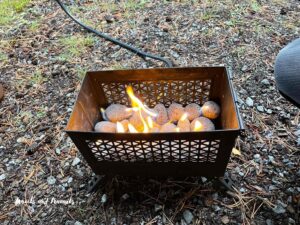
How Does a Propane Fire Pit Work, Anyway?
Fire pits come in all shapes and sizes, which is part of what makes them enjoyable to use. You have many options, from indoor and outdoor to wood-burning or propane pits.
Propane fire pits remain a popular choice because they burn cleanly, so no sparks fly out of the fire pit and onto your skin.
If you’ve ever had that happen to you (and I know I have, many times, personally), it makes you jump because it’s hot and painful. You can now spare your skin and clothing!
I’ll talk more about the upsides and downsides of propane fire pits later. For now, let’s discuss how they work so you can get a better idea of the warming solution you’re interested in for camping.
The fire pit contains a housing in which a propane tank’s gas line is connected. Atop the housing is a bowl that resists heat, then a burner underneath. Some propane fire pits have two burners, and others only one.
The burners are attached to a tank, which goes underneath the fire pit. Combustible gas comes from the tank and reaches the burners, achievable via an auto-ignite switch.
Alternatively, you can use a barbeque lighter or matches if the ignite switch fails.
Can You Safely Use a Propane Fire Pit When Camping?
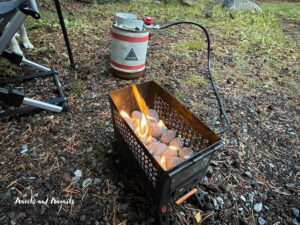
Now that you understand the components of an average propane fit pit, it’s time to answer your burning (get it?) question. Are propane fire pits safe to use when camping?
That depends on where you’re using yours.
Outdoors, a propane fire pit is an excellent choice. Indoors? Not so much.
Allow me to explain why.
Propane fire pits generate carbon monoxide, especially when the gas doesn’t burn clean. That’s usually likely in low-oxygen environments.
However, even when propane burns clean, carbon monoxide is a natural byproduct of combustion, so small amounts will always occur.
That’s not all. Propane also releases propane vapor. This is nontoxic but is an asphyxiant, so it will displace oxygen when inhaled, leaving you short of breath.
Outdoors, there’s enough fresh air that you’re less likely to inhale carbon monoxide and propane vapor directly. The wind will also carry these fumes away before you can breathe them in.
The Risks of Indoor Use of a Propane Fire Pit
However, indoors is a different story. There’s no moving air like a gentle breeze, so the gases can accumulate.
If you inhale enough propane vapor, you might experience symptoms like fatigue, emotional changes, sudden clumsiness, fast heart rate, and fast breathing. These symptoms will begin as oxygen levels deplete but are still available.
If you have even less oxygen to breathe, the symptoms of exposure worsen.
You can have convulsions, vomiting, nausea, and fall into a coma. You can even die if you don’t get out of the camper and seek medical attention pronto.
You might read the above paragraphs and think that wouldn’t happen to you. After all, you’d know when something is amiss and get out of there sooner.
Not necessarily! Propane vapor is odorless, a trait it shares with an even more deadly gas, carbon monoxide.
Carbon monoxide also lacks color or taste, so it can be in the air without you realizing it. The symptoms mimic exposure to propane vapors, causing breathing difficulties, disorientation, chest pain, fast heart rate, nausea and vomiting, weakness, dizziness, and headaches.
You could have a seizure and fall unconscious. Carbon monoxide poisoning is often fatal.
Understanding the symptoms and quickly exiting a dangerous environment is your best defense against carbon monoxide and propane vapor poisoning
You should also seek emergency medical assistance to receive oxygen.
The Pros and Cons of Propane Fire Pits
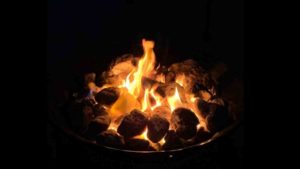
Before you decide whether a propane fire pit fits your camping plans, carefully review these pros and cons.
Pros
- Cleaner-Burning Than Most Fire Pits
The clean-burning nature of a propane fire pit ensures fewer sparks, as I mentioned, but that’s not all. The ash that can seemingly get everywhere whenever you light a fire pit is minimized when you choose propane.
You can keep your clothes and camper clean and enjoy a roaring fire and starlit sky every evening.
- Usable in Winter and Summer
Fire pits are an optimal combination of fun and functionality. They burn at 40,000 to 150,000 British thermal units and are customizable via a control knob.
Unlike most fire-related items you retire when the dog days of summer approach, you can continue using your propane fire pit.
Turning it on a low heat setting will combat the nip in the air after the sun finally sets. Into the autumn and early winter, cranking up that baby will allow you to stay outside, drinking in the peace and quiet.
- Low-Maintenance
Although they have many components, propane fire pits are easier to maintain than you’d imagine. Keep them clean between uses to ensure the pit burns cleanly every time, pour in extra propane, and check all the connections. That’s really about the extent of it.
Since propane is clean-burning, you can say goodbye to ash and soot, the worst part of having a fire pit.
- Don’t Require Much Space
Campers, celebrate. Fire pits are a much more size-smart heating solution than a portable space heater, especially if you travel via a small camper or RV. Propane pits especially won’t take up much valuable space so you can continue to pack light on all your adventures.
- Better for the Planet Than You’d Think
While ultimately, renewable sources are the best for our planet, propane gets an unnecessarily bad rap. It’s considered a low-carbon fuel source, meaning its rate of greenhouse gas emissions isn’t as high as other fuel sources.
- Great at Warming
If you’ve used other fuel sources for fire pits before, you’ll discover what I have. None of them produce warmth to the same extent as propane. The heat feels warmer, soothing your tense muscles and aching bones and inviting you to sit back, relax, and stay for a while.
- Many Styles Available
Propane fire pits come in all sorts of fun and funky styles sure to complement your personal taste and budget.
Cons
- Generates Dangerous Fumes
You’ll recall that carbon monoxide is a byproduct of even the cleanest-burning propane. This usually isn’t an issue if you fire up the pit outdoors, but indoors, even some carbon monoxide exposure can lead to adverse effects like tightness in the chest and headaches.
You should evacuate immediately and get to fresh air, preferably outside. Seek medical attention, even if you don’t feel poorly after breathing in cleaner air.
- Requires Constant Refills
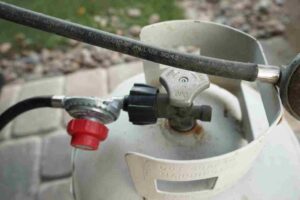
If you use a wood-burning fire pit, you can toss kindling or even old paper towel rolls onto the fire to keep it burning as long as you like. However, propane fire pits only last for so long…precisely until the tank is empty.
A 20-pound propane tank that can produce about 40,000 BTUs of heat should burn consistently for roughly 10 hours if you use a moderate heat setting.
However, the higher you turn up the warmth, the less time the propane lasts. The propane tank’s BTU output, the fire pit’s burn rate, and how long you use the pit also influence its longevity.
When you run out of propane, you have to get more if you want to continue enjoying the fire.
- Gets Expensive
Propane tanks aren’t cheap, which you’ll learn if you have to buy them often enough to enjoy a propane fire pit. Each time, you might wonder why you didn’t choose a resource like wood. You can generate enough kindling by spending a day out in the woods or holding onto toilet paper or paper towel rolls.
- The Tanks Take Up Space
The space-saving benefits of a propane fire pit are undone when you consider you must store at least a jug of propane in your small RV or camper trailer anytime you want to use the fire pit. If you try to stock up, you’ll need even more space.
The heavy propane tanks can possibly cause a weight distribution issue in your camper, which is yet another downside.
Propane Fire Pit Safety Tips for Your Next Camping Trip
Have you decided that a propane fire pit suits your camping style after reviewing the pros and cons? It’s important to be conscientious each time you light the fire pit to keep yourself and your fellow campers safe from harm.
These tips will help.
Invest in a Carbon Monoxide Detector
You should have a carbon monoxide detector in your RV or camper trailer regardless, but buying a propane fire pit is especially a good time to hook up the detector. Since you can’t see or smell carbon monoxide, you can’t say with 100 percent certainty whether it’s in your vehicle.
A carbon monoxide detector can tell you, allowing you to get out of harm’s way immediately.
Store Propane Carefully
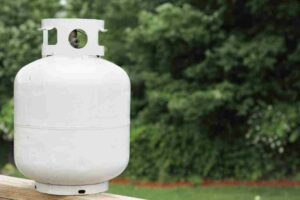
Propane can warm you in a jiffy but is also extremely flammable. You should always store propane tanks in a shaded environment. Keep the tanks away from any windows or heat sources, especially direct sunlight.
Don’t Let Propane Tanks Roll
Keep your propane tanks upright. When they roll, the valve can open, and the propane can spill, creating a dangerous scenario the next time you light a match in your motorhome.
Never Use Damaged Propane Tanks
Carefully check your propane tanks before you put one into the fire pit and light it. If the tank is compromised in any way, it could be dangerous to use, as it might leak. Rust, peeling paint, and dents are signs to throw away the tank immediately.
Don’t Cook in the Fire Pit
Some gas fire pits are designed for cooking, but most aren’t. If yours isn’t, do not use it for cooking, even roasting marshmallows. You especially shouldn’t use tin foil around a propane pit, as it’s a major fire hazard.
Keep Pets and Kids Out
You know how to safely use your fire pit, but your children and pets don’t. Keep them a reasonable distance from the fire while in use.
Never Leave a Burning Fire Pit Unattended
This last tip is the most important. You should always be in the vicinity of the fire pit when you’re using it. If you can’t monitor it, ask a fellow camper to do you a solid and watch it. Make sure to return the favor later!
Bottom Line
Propane fire pits are overall a safe camping option. They produce gloriously warm heat, are easy to use, and feature adjustable heat settings. However, since propane always releases carbon monoxide, you should never use a propane fire pit indoors.
Stay abreast of the symptoms of propane vapor and carbon monoxide poisoning so you can monitor your health and those of others you share your roaring fire with.
